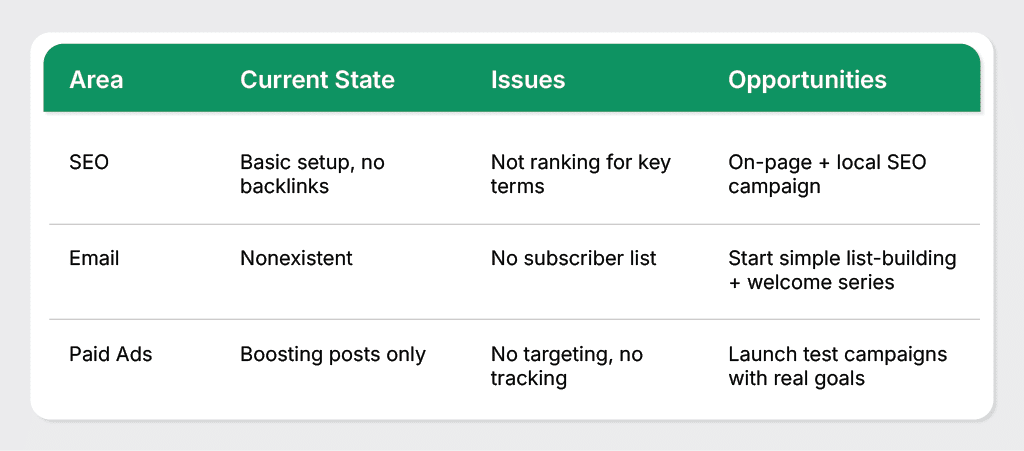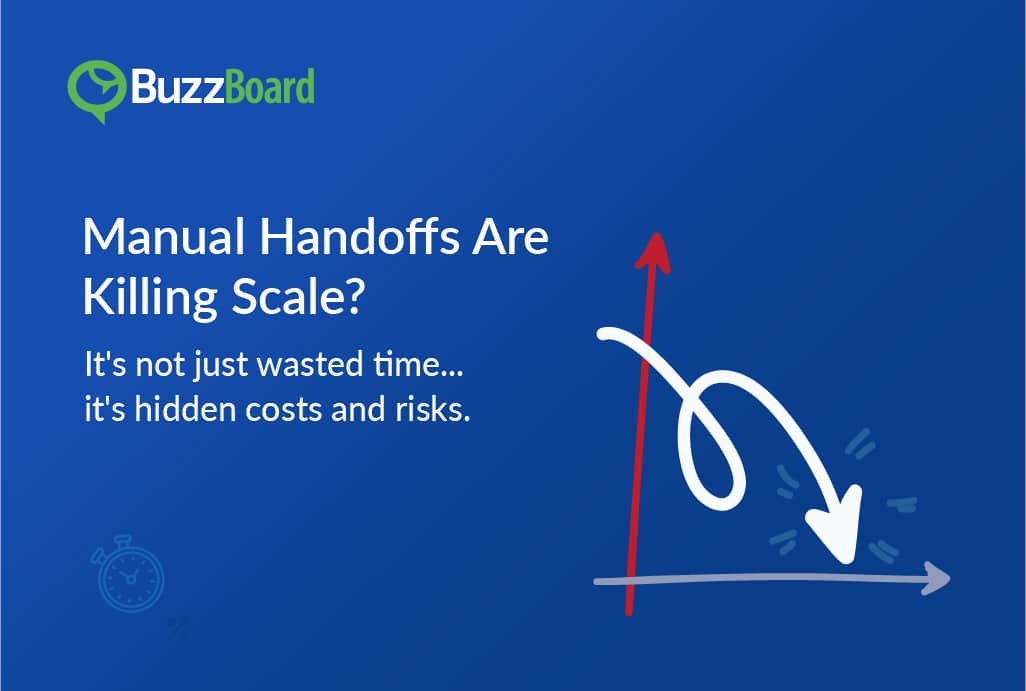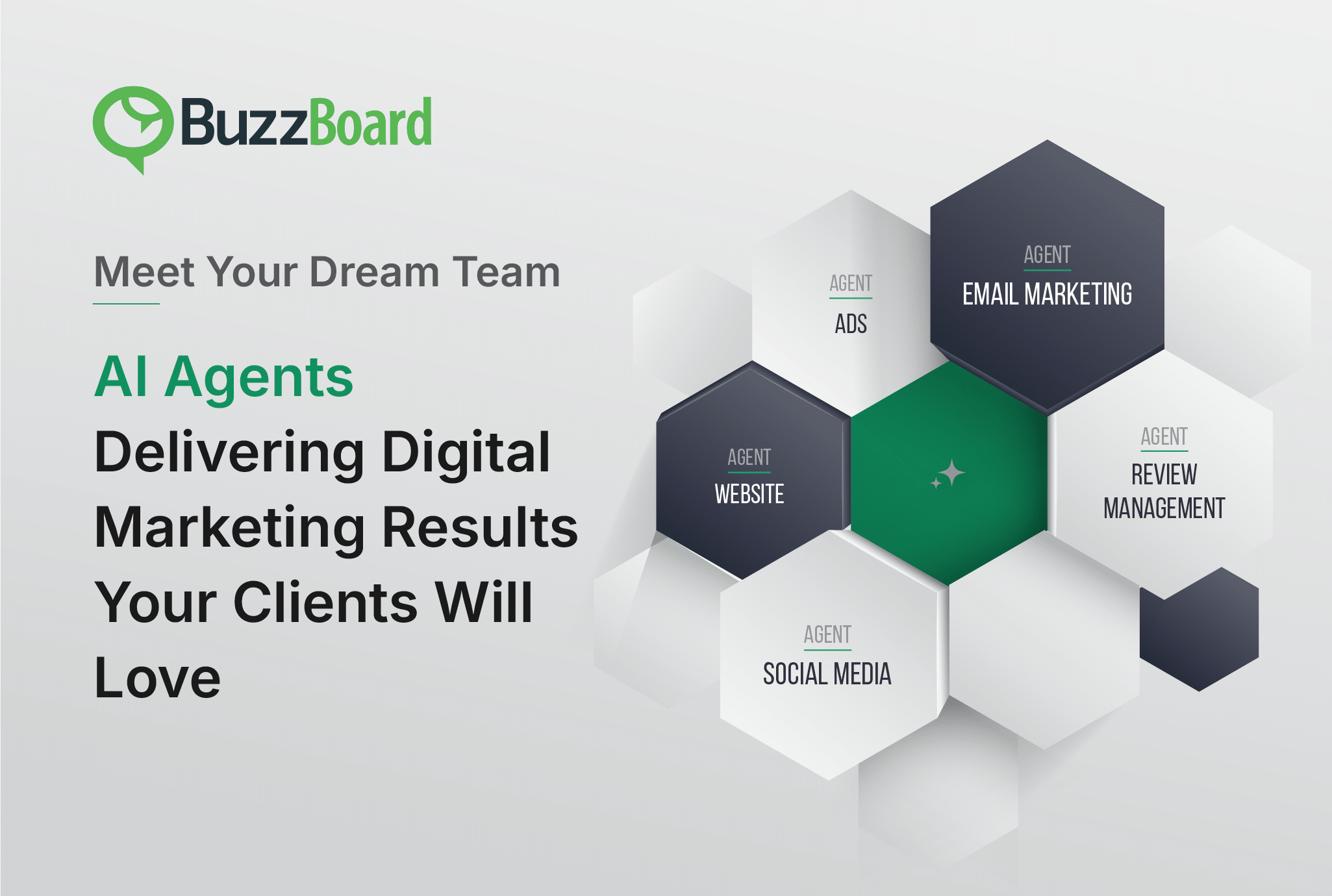Summary
A killer digital marketing strategy doesn’t start with ads, it starts with answers. With a comprehensive digital marketing needs assessment, your agency team can help small businesses zero in on what’s working, what’s broken, and where the real growth potential lies.
A proper digital marketing needs assessment for small businesses means stepping back to understand the full picture—business goals, audience, industry, and growth stage.
- Consider starting with a SWOT analysis to get the lay of the land.
- Then dive into the marketing ecosystem: Is the website optimized and converting? Is the SEO strategy more than just keywords? Are social, email, and paid efforts actually aligned or just scattered?
- Finally, look at what the competition’s doing, and what they’re missing. The goal? Uncover the gaps, spot the opportunities, and create a custom roadmap that’s not just tactical but strategic.
Understanding the Importance of a Comprehensive Digital Marketing Needs Assessment for Small Businesses
Because “just run some ads” isn’t a strategy.
Digital marketers working with small businesses know that no two clients are alike. A neighborhood bakery and a boutique SaaS startup might both fall under the ‘small business’ umbrella, but their digital marketing needs? Worlds apart. That’s where a Digital Marketing Needs Assessment comes in—a strategic deep dive that helps you figure out what’s really needed before you start throwing spaghetti (or ad dollars) at the wall.
You see, a comprehensive digital marketing needs assessment serves as an invaluable tool. This instrument can decode intricacies, align with goals and objectives, empowering digital marketing agencies to meet the needs of their small business clients effectively.
The strength of a digital marketing needs assessment stems from its ability to provide insight into the specific issues faced by small businesses. By scrutinizing current marketing strategies, identifying performance gaps, and outlining businesses’ unique requirements and objectives, these assessments give a complete picture of a company’s digital marketing landscape. This understanding enables digital marketing agencies to refine their strategies, aligning them with the distinct needs and goals of each small business client. Addressing these digital marketing dilemmas for small businesses is not just about pinpointing areas for improvement. It involves understanding the dynamics of the company’s industry, its target audience, and the competitive environment.
If you want to build trust, deliver results, and avoid scope creep purgatory, here’s how to conduct an effective and thorough digital marketing needs assessment for your small business clients.
How a Digital Marketing Agency Can Help Conduct a Comprehensive Digital Marketing Needs Assessment
When it comes to digital marketing for small businesses, the multitude of options and strategies available can be overwhelming. It’s often a challenge for these businesses to pinpoint their exact needs and pain points. Fortunately, that’s where digital marketing agencies come in. Conducting a comprehensive digital marketing needs assessment is a core service many agencies provide to support their small business clients—it shines a light on gaps in their marketing strategies and determines which digital channels will garner the most return on investment. Here are some basic tips on how to identify and address the digital marketing pain points for small businesses:
Remember, through detailed interactions with the client, posing key queries, and analyzing their current digital marketing endeavors, you can map an accurate landscape of their challenges. Maybe the small business client boasts of an exceptional product or service but struggles to draw online traffic. Or, they could have a skillfully designed website that, however, fails to convert visits into sales. It’s also common for such clients to underutilize social media as a promotional avenue.
Act Beyond the Basics: Why Your Digital Marketing Needs Assessment Needs an Upgrade?
Back in the day, a basic needs assessment might’ve included a few questions like:
Those questions still matter—but they’re no longer enough.
If your needs assessment doesn’t go beyond the basics, you’re not diagnosing—you’re guessing. And in 2025, educated guesses don’t pay the bills. Here’s what actually works in the AI marketing era:
Step 1: Understand the Business (Not Just the Website)
Before diving into tools and traffic sources, take a step back. Who are these people?
Pro tip: Ask, “What does success look like for you in the next 6–12 months?” It’ll tell you more than their analytics ever will.
Step 2: Audit the Existing Marketing Ecosystem
Now let’s roll up our sleeves and dig into the data graveyard.
Here’s what you’re looking for:
Quirky checklist item: Look at their last five marketing emails. If one of them has Comic Sans or no CTA, you’ve got your work cut out for you.
Step 3: Identify Gaps, Bottlenecks & Opportunities
Now it’s time to Sherlock this data and spot what’s missing:
Your goal is to uncover both problems (leaky funnels, inconsistent branding) and potential (untapped audiences, channels worth exploring).
Create a matrix or short summary highlighting:

Step 4: Align Solutions With Business Goals & Resources
Here’s where it gets real: recommend solutions that make sense for them, not just what’s trendy on LinkedIn.
Reality check: Not every business needs to be on TikTok. But most of them do need a clear CTA and a Google Business Profile.
Step 5: Present the Assessment as a Strategic Roadmap
This isn’t just a report; it’s a trust-building, client-convincing, scope-defining artifact. Package your findings into a neat, digestible roadmap.
Include:
Hot tip: Use visuals! Diagrams, heatmaps, traffic funnels—make it simple yet strategic.
From Vendor to Strategic Partner: The Real ROI of a Thorough Needs Assessment
A thorough digital marketing needs assessment is way more than just good practice—it’s a power move. It shifts you from being “the person who runs our ads” to “the expert helping us grow our business”. Here’s how that plays out:
It Opens the Door to Consultative Selling
Instead of jumping straight into tactics (“Let’s run Google Ads!”), you’re diagnosing root problems and co-creating solutions with the client. That’s a very different conversation—and one that positions you as a trusted advisor, not a vendor with a rate card.
It Leads to Bigger, More Strategic Engagements
When you uncover gaps across multiple channels—say, no lead nurture, weak SEO, and inconsistent messaging—you can propose phased, multi-channel strategies instead of one-off projects. And because the client sees that you get their business, they’re more likely to say yes. Try the following conversational energy:
“Let’s start with a lead gen campaign and map out your email follow-up funnel next quarter.”
That’s how you turn a $1.5K gig into a $15K relationship.
It Builds Long-Term Relationships (a.k.a. Retainers and Referrals)
When you deliver recommendations grounded in their goals, their data, and their capacity, clients stick around. Why? Because you’re not just executing, you’re guiding. That earns trust, ongoing work, and referrals.
Better Assessments = Better Clients
The deeper your understanding, the stronger your strategy. And the stronger your strategy, the more likely you are to land clients who value what you do—and are willing to invest accordingly.
Wondering how to get in front of your SMB prospects? BuzzBoard maximizes engagement and boosts your sales conversions with AI-generated, hyper-personalized communication that resonates. Do it at scale, across multiple media formats and channels, including emails, SMS, voice mails, visuals, and videos.
Diagnose first, prescribe second. A proper digital marketing needs assessment helps you dig deeper, ask smarter questions, and create solutions tailored to your client’s unique business, goals, and resources.
For digital marketers working with small businesses, it’s the foundation for everything. It gives you clarity, sets the tone for a consultative relationship, and makes sure you’re solving the right problems with the right strategies. It’s how you go from “freelancer” to “fractional CMO”. From ad-click peddler to trusted growth partner.
So next time a new client says, “We need help with marketing”, don’t jump to tactics. Grab your assessment toolkit, put on your strategist hat, and start diagnosing like the digital doctor you are.
Smart assessments build smart strategies. Smart strategies build great results. And great results? They build thriving client relationships and bigger retainers.









